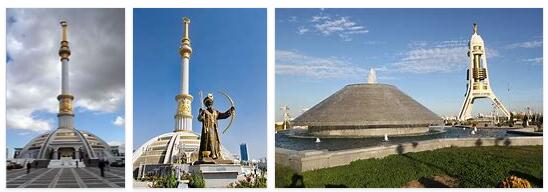Ashgabat – skyscrapers and wide boulevards
Ashgabat has about 860,000 inhabitants and is the capital of Turkmenistan. The city, which is also the largest city in the country of Turkmenistan, is located in an oasis in the Karakum desert at the foot of the Kopet-Dag mountains near the Iranian border. Ashgabat is an important industrial location for mechanical engineering, the food and textile industries. In the big city there are museums, theaters, several universities, a cultural center with a university and a zoo that is well worth seeing, which make it an interesting destination for study trips and tours. The city has its own international airport and is located on the Karakum Canal.
A city like out of a children’s book
The city could come from the imagination of a child’s room, where small children invent houses and other structures with their building blocks and colored pencils. Ashgabat’s streets and squares are wide, with white marble buildings up to 20 stories on their edges. The new wedding palace sits enthroned on a hill above Ashgabat and government and administrative buildings are lined up along the mountains to neighboring Iran.
The history of the city
The Turkmen capital Ashgabat was built around a Russian military base in the 19th century. In the 1940s, a devastating earthquake almost completely destroyed the city. A large part of the older building fabric was lost in the process, which led to the lack of the oriental old town in Ashgabat, which is typical for other Central Asian cities. The city is now characterized by buildings made of glass and reinforced concrete, which are considered earthquake-proof.
In the period since Turkmenistan’s independence from the Soviet Union in 1991, a rapidly growing new center has emerged. There are extensive parks and green spaces, huge skyscrapers and wide boulevards. In the southwest of the city there are high-rise buildings for offices, government, hotels and luxury living. The large number of richly modeled fountains is striking.
The Museum of Regional Studies, the Museum of Fine Arts and the History Museum are well worth seeing in Ashgabat. The city’s botanical garden is the most important of the many green spaces, with a collection of exotic and indigenous plants. Other worthwhile parks are the area around the Independence Tower and the park commemorating ten years of independence.
Bizarre architecture and a former dictator
Some areas of the cityscape are still shaped by the personality cult of the former head of state Saparmyrat Nyýazow. The 95 meter high Neutrality Tower, which was moved from the city center to the outskirts in 2010, is crowned by a golden statue of the dictator. The statue rotates once a day. Former President Niyazov, who died unexpectedly in 2006, had previously started to transform Ashgabat into a total architectural work of art. The dictator could be seen on banknotes and in the logo of the state television and had statues of himself and his family put up all over the country. Even the months were renamed after his family members and himself. Little changed after the dictator’s death. Successor Gurbanguly Berdimuhamedow, the former Vice President, presents himself today as a horse lover and as a “man of the people”. Politically, the current president was initially inconspicuous. In the meantime he is emulating his predecessor with its superlative architecture.
Nisa
A visit to the Parthian ruins in Nisa
The former city of Nisa is located in Turkmenistan, 12 kilometers west of today’s capital Ashgabat. It was the first capital of the Parthians, an Iranian people who built their empire in the Middle East from the 3rd century BC. The Parthian people built breathtaking buildings and made the city a worthy center of their ever-expanding empire. Historic Nisa was discovered during excavations in the 1930s. Systematic excavations have been carried out since then. The archaeological site of the historic city has been a UNESCO World Heritage Site since 2007.
The pentagonal fortress is surrounded by a gigantic wall. 8-9 meters thick and 5-7 meters high, it protected the former capital from enemies and intruders. The wall was guarded by 43 towers and consisted of tamped clay reinforced with bricks. The fortress, which was impregnable at the time, could be reached via a wide ramp. Inside the huge walls were a palace of the dead, a round temple and five impressive main bastions. In the huge royal palace there was a throne room as well as the 12 meter high Tower of Fire, in the top of which was the chancel. The most valuable possessions of the Parthian kings were housed in the treasury of the former palace: the finest silk fabrics, silver and gold jewelry, as well as artfully crafted weapons.
The finds from the excavations showed strong influences from different peoples. This was not surprising as Nisa was on the trade routes between Greece, Persia and Central Asia. In addition to life-size statues made of clay, clay jugs and plaster reliefs in typical Parthian style, marble sculptures and ivory drinking vessels were also found. The archaeological finds discovered during the excavations are now in the Museum of History in Ashgabat in Turkmenistan and in the Hermitage in St. Petersburg, Russia.
